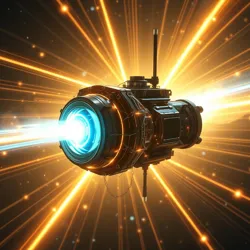Quantum Entanglement Communicator
The Quantum Entanglement Communicator is a groundbreaking technology that utilizes the principles of quantum mechanics to enable instantaneous communication across vast distances. This revolutionary device has transformed the field of interstellar communication by circumventing the traditional limitations imposed by the speed of light, making it a critical tool for maintaining contact between distant star systems and galactic civilizations.

An artist's impression of a Quantum Entanglement Communicator in operation.
Principles and Design
At the core of the Quantum Entanglement Communicator is the phenomenon of quantum entanglement. This process involves the entangling of pairs or groups of particles in such a way that the state of one particle is directly related to the state of another, regardless of the distance separating them. When a change is induced in one particle, its entangled partner reflects that change instantaneously.
The communicator itself consists of a sophisticated array of entangled particles housed within a secure and stable environment. This requires advanced containment technologies to prevent decoherence, which would otherwise disrupt the entangled state and compromise the communication link.
Development and History
The development of Quantum Entanglement Communicators was pioneered by the Quantum Mechanics Consortium, a collaborative effort between leading physicists and engineers from across the galaxy. Initial experiments were conducted using small-scale systems, and after successful trials, the technology was scaled up for practical use.
The first operational communicator was deployed by the Astral Nexus Federation, facilitating real-time communication between its far-flung colonies and research outposts. This marked a significant milestone in the history of space exploration and communication.
Applications and Impact
Quantum Entanglement Communicators have wide-ranging applications beyond mere communication. They are used in coordination with Light-Sail Signal Boosters to enhance signal clarity and reach in complex environments, such as near black holes or dense nebulae.
The technology also plays a crucial role in the Intergalactic Cultural Exchanges, enabling seamless and instantaneous sharing of knowledge, art, and culture between species spread across different star systems. However, these capabilities have sparked debates over privacy and the potential risks of unauthorized access to sensitive information.
Challenges and Limitations
Despite their advantages, Quantum Entanglement Communicators face challenges, particularly concerning the initial entanglement process, which requires precision and stability. Maintaining coherence over long periods and distances continues to be an area of active research, as does the development of methods to increase the number of entangled particles that can be managed simultaneously.
Future Directions
Future advancements in this field are focused on overcoming current limitations and enhancing the efficiency and reliability of these systems. There is ongoing research into integrating Neutrino-Based Communication and Gravitational Wave Messaging with quantum technologies to create hybrid systems that capitalize on the strengths of each method.
See Also
- Astral Nexus Federation
- Quantum Mechanics Consortium
- Light-Sail Signal Boosters
- Intergalactic Cultural Exchanges
References
- "Quantum Entanglement: Bridging the Cosmic Divide." Journal of Advanced Physics, 2023.
- "Realizing Instantaneous Communication: The Quantum Leap." Galactic Technology Review, 2023.
- "Challenges in Quantum Entanglement Communication." Quantum Mechanics Consortium Bulletin, 2023.
The Quantum Entanglement Communicator continues to be a focal point of innovation and discovery, offering profound insights into the potential of quantum mechanics to reshape our understanding and capabilities in the universe.